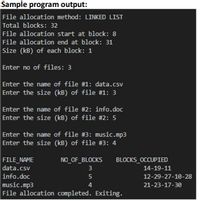
With linked allocation, each file is a linked list of disk blocks; the disk blocks may be scattered anywhere
on the disk. The directory contains a pointer to the first and last blocks of the file. Each block contains a pointer
to the next block. Refer to the illustration below.
Need help to fill in the codes in void main() ---
#include<stdio.h>
#include<stdlib.h>
#define TOTAL_DISK_BLOCKS 32
#define TOTAL_DISK_INODES 8
int blockStatus[TOTAL_DISK_BLOCKS]; // free = 0
int blockList[TOTAL_DISK_BLOCKS - TOTAL_DISK_INODES]; // list of blocks of a file
struct file_table {
char fileName[20];
int fileSize;
struct block *sb;
};
struct file_table fileTable[TOTAL_DISK_BLOCKS - TOTAL_DISK_INODES];
struct block {
int blockNumber;
struct block *next;
};
int AllocateBlocks(int Size) {
---
}
void main()
{
int i = 0, j = 0, numFiles = 0, nextBlock= 0, ret = 1;
char s[20]; struct block *temp;
---
for(i = 0; i < numFiles; i++) {
---
ret = AllocateBlocks(fileTable[i].fileSize);
---
}
---
//Seed the pseudo-random number generator used by rand() with the value seed
srand(1234);
---
}


Step by stepSolved in 2 steps

- createDatabaseOfProfiles(String filename) This method creates and populates the database array with the profiles from the input file (profile.txt) filename parameter. Each profile includes a persons' name and two DNA sequences. 1. Reads the number of profiles from the input file AND create the database array to hold that number profiles. 2. Reads the profiles from the input file. 3. For each person in the file 1. creates a Profile object with the information from file (see input file format below). 2. insert the newly created profile into the next position in the database array (instance variable).arrow_forwardAnalyze the problems carefully. Create the programs of the following. 1. Ages and Stages (Fle name: Age_Lastname) Create a program that checks as to which stage an age is. Use the table below. Age 5-12 years Stage Grade-schooler 13-17 years Теen 18-21 years Young adult 2. LRT-2 Single Journey Fare Matrix (File name: LRT_Lastname) Create a program that displays the fare based on the entered destination. The starting station is Araneta-Cubao. Use the table below. Use the code destination to shorten the user's input. Destination Fare Recto (Re) J. Ruiz (Jr) Gilmore (Gi) PHP 20 PHP 15 PHP 10arrow_forwardMASM x86 classarrow_forward
- You are implementing a simple file system for an operating system for managing files and folders; similar to Windows or UNIX. Your design should follow the following guidelines i) The entire file system is represented by an object which is the reference to the root folder ii) Any folder in the file system may contain two types of items, folders (subfolder) and files and you want to treat both in the same way iii) possible operations: getName, getPermission, listItem What is the most appropriate design pattern?arrow_forwardThe Directory class has a list of names in it. You should use dynamic memory to create anarray upon instantiation. You should create a copy constructor for the directory class and anassignment operator (i.e. operator=()). You should create a function called fillDirectory whichaccepts a size for the directory and the names for it both of which should be given by the user.In main, create directory1 and fill it with information. Use the assignment operator=() to setdirectory2 equal to directory1. This is in c++arrow_forward
 Computer Networking: A Top-Down Approach (7th Edi...Computer EngineeringISBN:9780133594140Author:James Kurose, Keith RossPublisher:PEARSON
Computer Networking: A Top-Down Approach (7th Edi...Computer EngineeringISBN:9780133594140Author:James Kurose, Keith RossPublisher:PEARSON Computer Organization and Design MIPS Edition, Fi...Computer EngineeringISBN:9780124077263Author:David A. Patterson, John L. HennessyPublisher:Elsevier Science
Computer Organization and Design MIPS Edition, Fi...Computer EngineeringISBN:9780124077263Author:David A. Patterson, John L. HennessyPublisher:Elsevier Science Network+ Guide to Networks (MindTap Course List)Computer EngineeringISBN:9781337569330Author:Jill West, Tamara Dean, Jean AndrewsPublisher:Cengage Learning
Network+ Guide to Networks (MindTap Course List)Computer EngineeringISBN:9781337569330Author:Jill West, Tamara Dean, Jean AndrewsPublisher:Cengage Learning Concepts of Database ManagementComputer EngineeringISBN:9781337093422Author:Joy L. Starks, Philip J. Pratt, Mary Z. LastPublisher:Cengage Learning
Concepts of Database ManagementComputer EngineeringISBN:9781337093422Author:Joy L. Starks, Philip J. Pratt, Mary Z. LastPublisher:Cengage Learning Prelude to ProgrammingComputer EngineeringISBN:9780133750423Author:VENIT, StewartPublisher:Pearson Education
Prelude to ProgrammingComputer EngineeringISBN:9780133750423Author:VENIT, StewartPublisher:Pearson Education Sc Business Data Communications and Networking, T...Computer EngineeringISBN:9781119368830Author:FITZGERALDPublisher:WILEY
Sc Business Data Communications and Networking, T...Computer EngineeringISBN:9781119368830Author:FITZGERALDPublisher:WILEY





